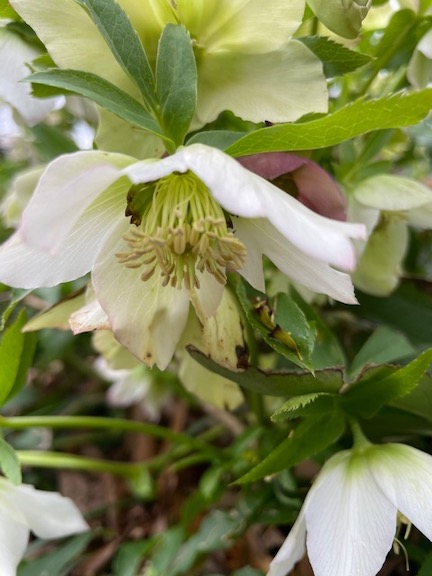Every winter when I look out at my garden, I am grateful for the huge clumps of Lenten rose, or Helleborus, that create islands of beauty in the midst of an otherwise sparse landscape. And every year my winter enthusiasm pales a bit by July when these same welcomed clumps seem to be pushing and shoving their way into every nook and cranny of my garden, crowding out other, more timid plants.

Lenten rose is anything but shy. Seemingly unfazed by nasty, cold, drizzly weather and short days of pale sun, this plant blooms profusely. The blossoms are nodding, with their stamen and pistils pointing toward the ground, which offers some protection from inclement weather and improves the chance of pollination. It is a welcome addition to the garden for bees busy pollinating early in the season.

The showiest parts of the flower are the petal-like sepals which come in a range of hues from greenish to pure white to light pink, mauve and deep pink. Lenten rose is a member of the Buttercup family and is a hybrid, developed by crossing Helleborus orientalis with a few other Helleborus species. Scientifically, it is known as Helleborus xhybrida. Don’t confuse it with Christmas rose, Helleborus niger, which is native to alpine regions of Europe and notoriously difficult to grow in Georgia.

Because it is a hybrid, plants that come from seeds will not look exactly like the parent plant, meaning that if you have a lot of Lenten roses, you’re going to probably have a lot of different colors.I love this mix of shades, though I think the pure white ones are probably my favorite. For whatever reason, I seem to have twice as many white blossoms this year as I did in years past.

Lenten rose is really, really easy to grow within its range (horticultural growing zones 5 – 9). I may have mentioned that it has become a bit aggressive in my garden. I like to consider myself an equal opportunity gardener and strive for diversity. It is a constant struggle, however, since some plants, such as the Lenten rose (and Arum, False Solomon’s seal, and Black-eyed Susans) want to take over my little world. I am forever digging up these wonderful plants to give away to friends and neighbors so that I can introduce new and different species into my garden.

But, it’s early March and all those “new and different species” are still just in my imagination. And the reality is, it warms my heart and makes me want to shout with joy when I see the Lenten rose pointing the way toward spring.
